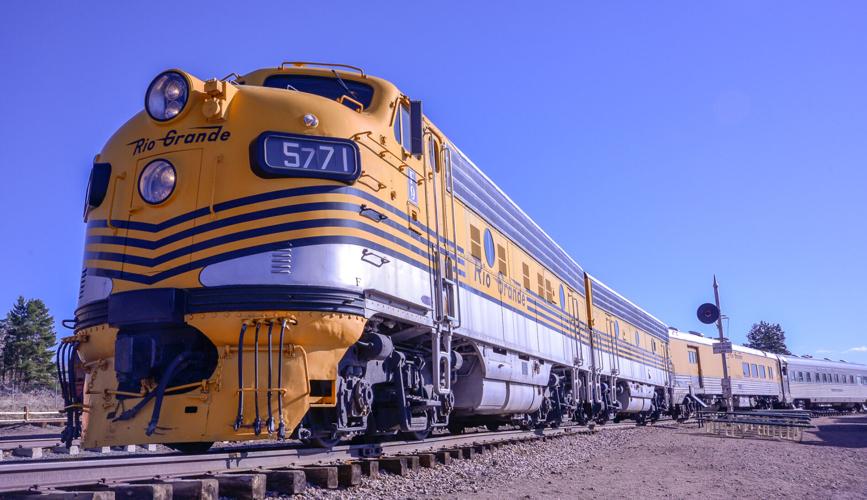On March 20, 1949, the first run of a new streamlined passenger train made for passenger comfort and enjoyment left Oakland, Calif. headed for Chicago.
The three-day, two-night, 2,438-mile cross-country trip aboard the California Zephyr has become one of America’s most iconic and popular scenic rail journeys.
Built for comfort, not speed, the train was intended to let passengers enjoy the scenery of the west, including the dramatic Glenwood Canyon and the Colorado Rocky Mountains.
It was the first transcontinental passenger train to use Vista Dome observation cars that provide stunning 360-degree views of the countryside.
“It's the 75th anniversary of the inauguration of the California Zephyr, which at the time that it was inaugurated in 1949 was a new kind of train,” Paul Hammond, executive director of the Colorado Railroad Museum told The Denver Gazette. “It was one that was no longer racing to be the fastest.”
That was the typical plan used prior to the Zephyr, currently operated by Amtrak — get there as fast as possible.
Hammond said that steam trains of the past crossed Wyoming at 125 miles per hour.
At a time when interstate highways were being built and the jet airplane was just coming into existence, railroads realized maybe it's better to have a train that is all about the journey, not just about getting there fast, Hammond said.
The trip across America gives passengers a tour of geography and culture, climbing the Rocky Mountains and passing deep under the Continental Divide through the 6.2-mile-long Moffat Tunnel at the trip’s highest elevation of 9,270 feet above sea level.
“I think of the grandeur of Colorado. Everybody thinks of Glenwood Canyon and that's beautiful, but there's several other really spectacular points. Climbing up from the front range is one of them, through the Flatirons,” said Hammond. “And you also then have the Eagle River Canyon. So, there's some really beautiful canyons along the way.”
Today the train stops at 37 stations along the route, and in many smaller communities Amtrak said it is the only option for intercity transportation.
In Colorado the train stops daily in Fort Morgan, Denver, Fraser-Winter Park, Granby, Glenwood Springs and Grand Junction.
In September 1950 a monument to the Vista Dome rail car was erected in Glenwood Canyon, opposite the rail line that first opened in 1887.
Built by the Rio Grande railroad and General Motors, and inspired by General Motors executive Cyrus Osborn, who came up with the domed rail car idea during a 1944 trip through Glenwood Canyon, the stone arch carried a miniature replica Vista Dome rail car.
It was an iconic stop for travelers through Glenwood Canyon on the original two-lane highway, but in the 1970s people started using the rail car as a target and the car was removed and placed in storage.
When the new I-70 dual-level interstate highway was built between 1980 and 1992, there was no place for the monument, so it was moved to the Colorado Railroad Museum in the summer of 1985 and the damaged model was repaired and reinstalled atop the arch.
Moving the monument turned out to be a monumental task, said Hammond. It weighs 29 tons and moving it was dramatic, according to Darrell Arndt, who worked on the project.
“It was a challenge figuring out how to move the big foundation, figuring out how to pick it up, how to put it on a truck, and then as an overweight, over-height load, drive it under cover of darkness here to Golden and almost tip over the crane that placed it on the ground here,” Hammond said. “All kinds of interesting drama that came out in the photographs that we got this week from Darrell Arndt, right here in the front, who helped put this whole crazy idea together.”
Officials re-dedicated the monument Saturday at the railroad museum in conjunction with the California Zephyr's 75th anniversary.
The Colorado Railroad Museum was started by Robert W. Richardson in Alamosa at a time when Colorado’s narrow-gauge railroads started going out of business in the 1940s. Richardson began collecting rolling stock and railroad records to preserve Colorado’s railroad history. In 1958, running out of room in Alamosa, Richardson and Cornelius W. Hauck purchased land in Golden and moved all of the locomotives and cars there.
Included in the museum’s collection is diesel-electric locomotive No. 5771, its B-unit No. 5762, and two rail cars that were used on the route.
Kip Davis, a volunteer docent and railroad worker who operated No. 5771, explained the locomotive’s operation in the cab to visitors during the commemoration.
“This site first welcomed guests in 1959. So, we're actually celebrating our 65th year this year, and the museum has grown immensely,” said Hammond. “We just welcomed about a hundred thousand guests last year, which is a new record for us.
“We haven't thrown a commemoration event like this one before,” Hammond added. “I hope we have some more opportunities, but we run trains every Saturday. In the summer months, we'll go to a four day a week schedule on that. We're really trying to be a place people want to come throughout the year to explore Colorado's rich railroad heritage.”
For more information go to the Colorado Railroad Museum website.












(0) comments
Welcome to the discussion.
Log In
Keep it Clean. Please avoid obscene, vulgar, lewd, racist or sexually-oriented language.
PLEASE TURN OFF YOUR CAPS LOCK.
Don't Threaten. Threats of harming another person will not be tolerated.
Be Truthful. Don't knowingly lie about anyone or anything.
Be Nice. No racism, sexism or any sort of -ism that is degrading to another person.
Be Proactive. Use the 'Report' link on each comment to let us know of abusive posts.
Share with Us. We'd love to hear eyewitness accounts, the history behind an article.